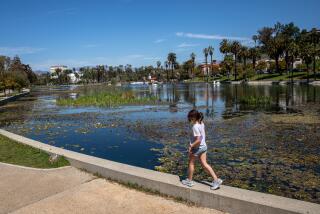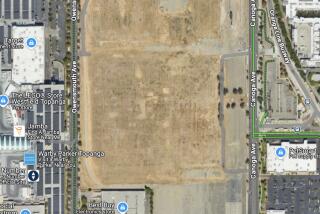Water Table at Dump Site Free of PCBs : Tests Could Spur Cleanup Plan by October for Escondido Site
- Share via
ESCONDIDO — Testing at the Chatham Brothers toxic waste site has revealed that industrial solvents and fuel oil seeped into ground water but has so far ruled out the presence of any cancer-causing PCBs in the water table, authorities said Friday.
“We didn’t get any surprises out there,” said Chris Irwin, a press aide for Supervisor Paul Eckert. “If anything, it confirms our suspicions as to what we’d find out there and at what levels.”
The tests, being conducted by state and county toxic waste experts, indicate that PCBs are present in sections of ground on the six-acre site, where brothers Thomas and Robert Chatham ran a business until 1982 that recycled solvents and waste oil. In addition, the area had been a dumping ground for metal drums of industrial chemicals.
Officials, however, say PCBs have not been detected in any of the four test wells drilled on the property, which is located in a rural residential area of Escondido. Solvents and fuel oil found in three of the wells pose no immediate threat, they say. No test wells have been drilled in the region surrounding the parcel.
While authorities had determined more than a year ago that there was no immediate danger at the site, some had remained worried that PCBs might have percolated through the soil and into the ground water. The water table feeds into nearby Lake Hodges, a reservoir.
The monthlong tests, which began in early July, are being performed to help authorities determine just how to clean up the land. Considered to be the worst case of toxic dumping in San Diego County, the Chatham site is the first in California targeted in a hazardous waste cleanup program authorized by state voters in 1984.
With the test results as a guide, state officials expect to have a strategy by October for cleaning up the site. The cleanup could cost up to $2.9 million and take a year to complete.
“What we have are what we would consider elevated levels of PCBs,” said Megan Cambridge, an associate hazardous material specialist with the state Department of Health Services. “We now have to make an assessment of how they need to be managed.”
Using a backhoe, toxic experts dug four trenches on the site, finding PCBs primarily in the central area where the Chatham brothers had operated stills to recycle the solvents and other chemicals, Irwin said.
Ten barrels were unearthed, one of which contained traces of PCBs, according to Cambridge. Experts also unearthed pockets of black, molasses-like sludge containing high levels of PCBs.
According to Irwin, one of the trenches contained two different types of PCBs, one with a strength of 2,700 parts per million, the other registering 16,000 parts per million. Experts consider levels of more than 50 parts per million of the toxin to be hazardous.
Cambridge said traces of PCBs were detected from about three feet below the surface to depths of six feet. Since officials went no deeper, further tests will be needed to determine if chemicals have seeped farther into the ground, Cambridge said. That work, however, could be performed in conjunction with the task of cleaning up the parcel, she said.
As yet, there are no results of tests on a small pond on the site, but officials are confident the area will prove free of contamination, Irwin said.
County and state health officials have been attempting to get the area cleaned up since 1982, but those efforts stalled because the Chatham brothers had sold the property to Coastal Equities, a real estate investment firm that later went bankrupt. The Chathams have refused to pay for the cleanup.
The property was never considered dangerous enough to receive federal cleanup funds. Money from the state was not available until earlier this year, when the Legislature allocated the funds approved by voters in 1984.
More to Read
Sign up for Essential California
The most important California stories and recommendations in your inbox every morning.
You may occasionally receive promotional content from the Los Angeles Times.










